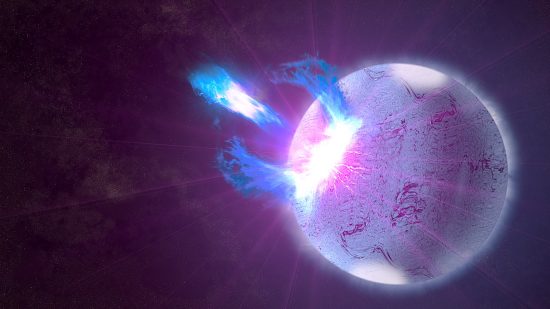
October 20, 2020
FRBs are not gravity bombs.
About ten years ago, astronomers discovered what they call a “Fast Radio Burst”, or FRB. It was estimated that the event released more energy in five milliseconds than the Sun puts out in a month. The source was said to be a billion light-years away, and was speculated to come from the death of a black hole.
According to a recent press release, there appear to be three FRBs that repeat their blasts of energy over time. This is a conundrum: FRBs are supposed to occur only once, since they are thought to derive from explosions that destroy their sources, evaporating black holes, neutron star collisions, or hypernovae.
In an Electric Universe, extreme celestial objects, emitting radio waves of such magnitude, can not and do not exist. Computer simulations demonstrate that plasma phenomena are scalable over several orders of magnitude: they behave in the same way and illustrate basic premises whether in atoms or galaxies. When charged particles accelerate in electric fields, they emit synchrotron radiation, creating X-rays, gamma-rays and radio waves.
Plasma formations in space can be modeled in the laboratory due to that scalability factor. Plasma discharges produce the same formations independent of size. Since duration is proportional to size, an electric spark that lasts for microseconds in the laboratory might last for years at the stellar scale, or for millions of years at the galactic scale. Or, they might suddenly erupt and then dim again.
Electric Universe advocates propose that FRBs are most likely occurring in nearby galactic neighborhoods, so they are not unimaginably powerful, and not coming from the edge the Universe. Since plasma discharges in the form of exploding double layers can accelerate particles in ways that are confirmed with laboratory experiments, then it is there that the source for powerful energy bursts should be explored.
Plasma physicist and Nobel laureate, Dr. Hannes Alfvén thought that “exploding double layers” should be considered a new class of celestial object. Z-pinches in plasma filaments create plasmoids that evolve into stars and galaxies. Electricity is responsible for stellar behavior, and when the current density gets too high, double layers in the circuit catastrophically release their excess energy, appearing as FRBs, X-rays, or flares of ultraviolet light.
As mentioned, FRBs are probably nearby. Plasma more correctly explains them, and it is exploding double layers that impel them. Rather than relying on mathematical phantoms like black holes in tandem with overweight neutron stars, why not create real, testable hypotheses and work them up with real, physical models? FRBs are flashes of cosmic lightning erupting from electrified clouds of plasma on an immense scale.
Stephen Smith












